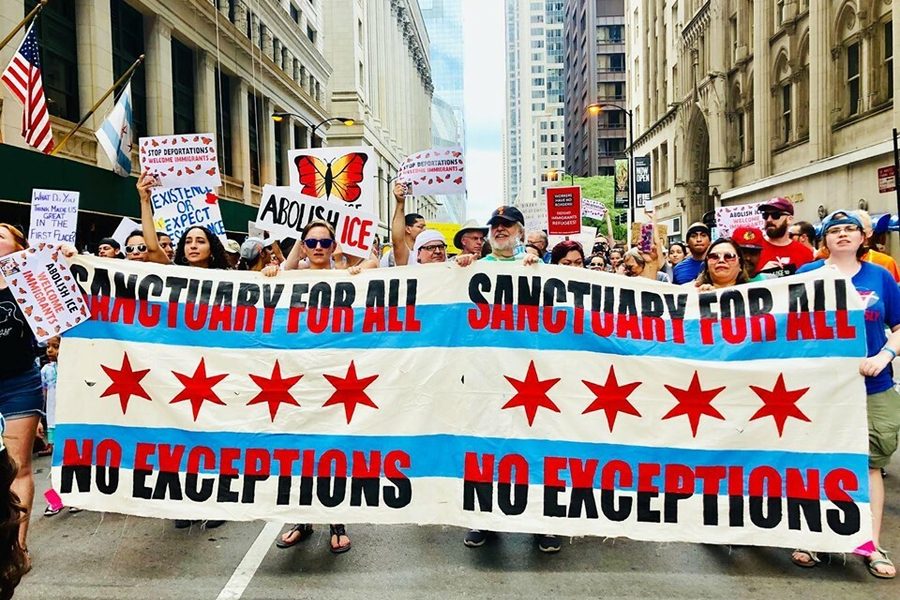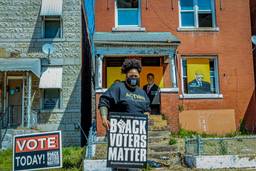Activists Say Lori Lightfoot Is Not Meeting Their Demands to Protect Immigrants
Chicago’s new mayor is refusing to shut down the city’s infamous gang database, despite concerns that it makes residents more vulnerable to ICE.
Skyler Aikerson

On July 13, more than 4,000 people rallied in Chicago to protest President Trump’s immigration crackdown — part of a nationwide day of action. But organizers also directed grievances at another politician: Chicago Mayor Lori Lightoot, who is refusing to shut down the Chicago Police Department’s (CPD) infamous gang database, despite evidence that it disproportionately targets Black and Latinx people — and gives Immigration and Customs Enforcement (ICE) another tool to go after Chicagoans.
“The youth demands the gang database be erased,” Keishjuan Owens, a youth leader with Brighton Park Neighborhood Council, told the crowd. “It puts so many people like you and me in harm’s way, targets undocumented folks, limits access to opportunities, jobs and schooling.”
After Trump threatened to unleash sweeping immigration raids starting July 14, Lightfoot announced that the CPD would not cooperate with ICE, and that ICE agents would not have access to the gang database, known as the Citizen and Law Enforcement Analysis and Reporting (CLEAR) database.
Mony Ruiz-Velasco, the executive director of Proyecto de Acción de los Suburbios del Oeste (PASO), a local immigrants’ rights organization, told In These Times Saturday before the rally that this gesture goes “beyond anything that any of the previous mayors were ever willing to do.”
Yet, Ruiz-Velasco said it is not enough: “We would like to see those databases eliminated.”
At Saturday’s march, organizers and speakers repeated this call for the gang database to be shut down.
“Our message is consistent: We want the gang database closed,” said Darcey Regan, executive director of Indivisible Chicago.
The gang database, which originated in 2002 under the Richard M. Daley administration, includes information on Cook County residents the CPD claims are “criminal offenders” or affiliated with “gangs.” Black and brown Chicagoans are disproportionately targeted and added to the database for supposed gang affiliation. The Chicago Tribune reports that “96 percent of the nearly 65,000 people identified as suspected gang members are Black or Latino.” According to ProPublica Illinois, the database has been accessed over a million times in the past decade by many organizations and agencies, including ICE. A report by Joe Ferguson, Chicago’s inspector general, found that between 2009 and 2018, “more than 32,000 queries came from federal immigration authorities.” Ferguson’s report recommended that stronger standards be put in place to make sure the gang database is accurate, and that the CPD evaluate the usefulness of the database itself.
The database has been shown to contain inaccurate or misleading information, such as listing people as 0 years old, or including people who had not been arrested or accused of a crime. The criteria for being added to the database are vague, and people can be added simply because a police officer claims to have “special intelligence on the subject of gangs.”
These murky criteria have led to the profiling of Black and Latinx people. In 2017, two men brought separate lawsuits against the CPD, arguing that they had been profiled as gang members and erroneously put in the database. One of them, Wilmer Catalan-Ramirez, was subsequently arrested and detained by ICE. After being detained for 10 months, he was released in January 2018.
The database has been the target of repeated protests. In October 2017, during Rahm Emanuel’s administration, Organized Communities Against Deportations (OCAD) and Black Youth Project 100 protested outside of City Hall with three large art installations that criticized the gang database, as well as Emanuel’s proposed cop academy.
Lightfoot has suggested that the gang database should undergo some changes to improve accountability and transparency, such as creating a system for auditing information. She also has said, “[T]here can be legitimate purposes for collecting that data [in the gang database]. But that’s the rub: legitimate purposes.”
Closing loopholes
Lightfoot is declining to meet another community request to protect immigrants. According to OCAD, on June 29, Lightfoot’s office received an executive order drafted by the Immigration Working Group, which consists of several community organizations (including OCAD). If signed, the executive order would ensure the CPD cannot work with ICE in any capacity, and it would close loopholes in Chicago’s pre-existing Welcoming City ordinance, created in 2012. Rey Wences, an organizer with OCAD, said the ordinance allows police to work with ICE, for instance, if someone is in the gang database or if someone has a felony conviction or charge. They say, “As we know, there’s been an increase in criminalization. And there are people that have felonies but they are made up of non-violent offenses.”
This executive order would “codify the statements the mayor made,” says Wences.
The community’s proposed executive order closes an important loophole by denying not only ICE, but any other agency within the Department of Homeland Security, “direct access to any electronic database or other data-sharing platform” belonging to the CPD.
Antonio Gutierrez, an organizer with OCAD, told In These Times that the community executive order, if signed by Lightfoot, would ensure that the CPD “would not be participating or collaborating with ICE in any situation.” Guttierrez said that because Lightfoot’s announcement and subsequent package of executive actions do not explicitly address the loopholes in the Welcoming City ordinance, she leaves room for potential CPD and ICE collaboration.
Lightfoot told the Chicago Sun-Times that she would not sign OCAD’s executive order. “It would be easy to pander to the crowd,” she said. “But I want to do this in a way that’s actually gonna be meaningful and structural and lasting.”
“The fact that she did not sign the executive order is unfortunate,” said Wences.
On Friday, Curbed Chicago reported that Lightfoot signed a separate package of executive actions that restricts ICE’s access to public facilities, such as parks and libraries, and increases funding towards Chicago’s Legal Protection Fund.
Concerned about what a potential escalation in immigration raids could mean for Chicago, residents are preparing for the worst. Saturday’s march also aimed to connect Chicagoans to various resources for help in case of ICE arrests, such as the Illinois Coalition for Immigrant and Refugee Rights’ Family Support Hotline. Organizers urged allies to take further, sustainable action by getting involved with local organizations and actions, such as neighborhood bike and foot brigades, which patrolled and defended Chicago neighborhoods against ICE activity on Sunday. With the support of democratic socialist alderwoman Rossana Rodriguez, Chicagoans flocked to Albany Park, a neighborhood with a large population of Central American refugees, where they were trained on how to spot and act against potential ICE activity. As of July 15, the Chicago Tribune reports that there have been no signs of ICE raids in the city. However, the Tribune reports that officials have said that “the sweeps will continue through the coming week.”
Skyler Aikerson is a freelance reporter based in Chicago and a former In These Times intern.






